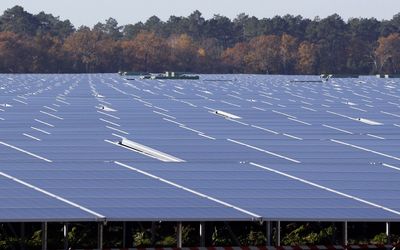LOAD shedding has been part of South Africans’ daily lives and, with projected electricity shortages, is likely to remain an inconvenience for some time.
A new government intervention to encourage the development of solar units recently took effect, but tax experts question how effective it will be in encouraging the adoption of solar energy.
The Income Tax Act already provides for an accelerated capital allowance on assets used in the production of electricity in the renewable energy sector by means of wind, biomass or hydro generation.
However, the government has decided to accelerate depreciation from the current three-year period to a one-year period of 100% depreciation. It applies only to small-scale solar photovoltaic (PV) renewable energy with a generation capacity of less than 1MW.
The Treasury said in its explanatory memorandum in December that the improved incentive should increase uptake of small-scale embedded solar photovoltaic units.
Izak Swart, tax director at Deloitte’s research and development and government grants division, says the accelerated tax deduction provides a cash-flow benefit only in the year when the solar panels are brought into use.
"Some see the cash-flow benefit as an incentive, but to my mind this is a very limited incentive. If we really wanted to incentivise solar panels, an additional tax deduction should be made available as opposed to an accelerated tax deduction."
Mr Swart, also vice-chairman of the South African Institute of Tax Practitioners’ incentives committee, says the act allows for a 150% tax deduction on qualifying research and development expenditure. The additional 50% is the real incentive and will make a difference to the financial results of a company.
"It is doubtful if more manufacturers will start producing solar panels just because of the change in tax legislation. I think market forces will determine if they start producing more solar panels in SA," says Mr Swart.
"The uptake of solar power may increase because of the deduction and will certainly enhance the viability to do so. However, an additional tax deduction will be far more preferable and make a much larger impact."
Mazars senior tax consultant Patrick Emmett says it is important to note that government is not providing a subsidy or grant, but a capital allowance claimed as a deduction against taxable income.
He also notes that the allowance is not available to an individual or a household for domestic use. "The asset must be used in the taxpayer’s trade," he says.
Any foundation or supporting structure that is critical to the operation of the asset will also qualify for the allowance, says Mr Emmet.
Mr Swart explains that a 1MW power plant produces 1,000 kilowatts of power each hour it operates.
The Department of Energy says on its website most areas in SA average more than 2,500 hours of sunshine a year.
Mr Swart says this equates to 2,500MWh a year or 6,849kWh a day. "This could easily power a small-scale manufacturing facility, a small-sized private hospital or a couple of office buildings."
He says it can generate enough power for eight office buildings similar to Deloitte’s building in Woodmead, Johannesburg.
The department says the use of solar energy is the most readily accessible resource in SA. It lends itself to a number of potential uses and the country’s solar-equipment industry is developing.
Mr Swart says the price of solar panels still needs to drop further to get a higher uptake. However, the ability to keep the grid stable and increases in the price of electricity will have a significant effect on the uptake of solar power.
The development and enhancement of energy storage needs to develop more quickly to enable users to become self-reliant on energy from solar panels.
The amendment has been enacted and is effective from January this year.

Solar energy. Picture: REUTERS/REGIS DUVIGNAU
LOAD shedding has been part of South Africans’ daily lives and, with projected electricity shortages, is likely to remain an inconvenience for some time.
A new government intervention to encourage the development of solar units recently took effect, but tax experts question how effective it will be in encouraging the adoption of solar energy.
The Income Tax Act already provides for an accelerated capital allowance on assets used in the production of electricity in the renewable energy sector by means of wind, biomass or hydro generation.
However, the government has decided to accelerate depreciation from the current three-year period to a one-year period of 100% depreciation. It applies only to small-scale solar photovoltaic (PV) renewable energy with a generation capacity of less than 1MW.
The Treasury said in its explanatory memorandum in December that the improved incentive should increase uptake of small-scale embedded solar photovoltaic units.
Izak Swart, tax director at Deloitte’s research and development and government grants division, says the accelerated tax deduction provides a cash-flow benefit only in the year when the solar panels are brought into use.
"Some see the cash-flow benefit as an incentive, but to my mind this is a very limited incentive. If we really wanted to incentivise solar panels, an additional tax deduction should be made available as opposed to an accelerated tax deduction."
Mr Swart, also vice-chairman of the South African Institute of Tax Practitioners’ incentives committee, says the act allows for a 150% tax deduction on qualifying research and development expenditure. The additional 50% is the real incentive and will make a difference to the financial results of a company.
"It is doubtful if more manufacturers will start producing solar panels just because of the change in tax legislation. I think market forces will determine if they start producing more solar panels in SA," says Mr Swart.
"The uptake of solar power may increase because of the deduction and will certainly enhance the viability to do so. However, an additional tax deduction will be far more preferable and make a much larger impact."
Mazars senior tax consultant Patrick Emmett says it is important to note that government is not providing a subsidy or grant, but a capital allowance claimed as a deduction against taxable income.
He also notes that the allowance is not available to an individual or a household for domestic use. "The asset must be used in the taxpayer’s trade," he says.
Any foundation or supporting structure that is critical to the operation of the asset will also qualify for the allowance, says Mr Emmet.
Mr Swart explains that a 1MW power plant produces 1,000 kilowatts of power each hour it operates.
The Department of Energy says on its website most areas in SA average more than 2,500 hours of sunshine a year.
Mr Swart says this equates to 2,500MWh a year or 6,849kWh a day. "This could easily power a small-scale manufacturing facility, a small-sized private hospital or a couple of office buildings."
He says it can generate enough power for eight office buildings similar to Deloitte’s building in Woodmead, Johannesburg.
The department says the use of solar energy is the most readily accessible resource in SA. It lends itself to a number of potential uses and the country’s solar-equipment industry is developing.
Mr Swart says the price of solar panels still needs to drop further to get a higher uptake. However, the ability to keep the grid stable and increases in the price of electricity will have a significant effect on the uptake of solar power.
The development and enhancement of energy storage needs to develop more quickly to enable users to become self-reliant on energy from solar panels.
The amendment has been enacted and is effective from January this year.



















Change: -0.97%
Change: -0.99%
Change: -0.84%
Change: -1.10%
Change: -0.61%
Data supplied by Profile Data
Change: 0.24%
Change: -1.10%
Change: -0.97%
Change: 0.00%
Change: -1.42%
Data supplied by Profile Data
Change: -0.14%
Change: -0.10%
Change: -0.21%
Change: 0.43%
Change: -0.91%
Data supplied by Profile Data
Change: -0.08%
Change: -0.22%
Change: 0.07%
Change: -0.58%
Change: 0.51%
Data supplied by Profile Data